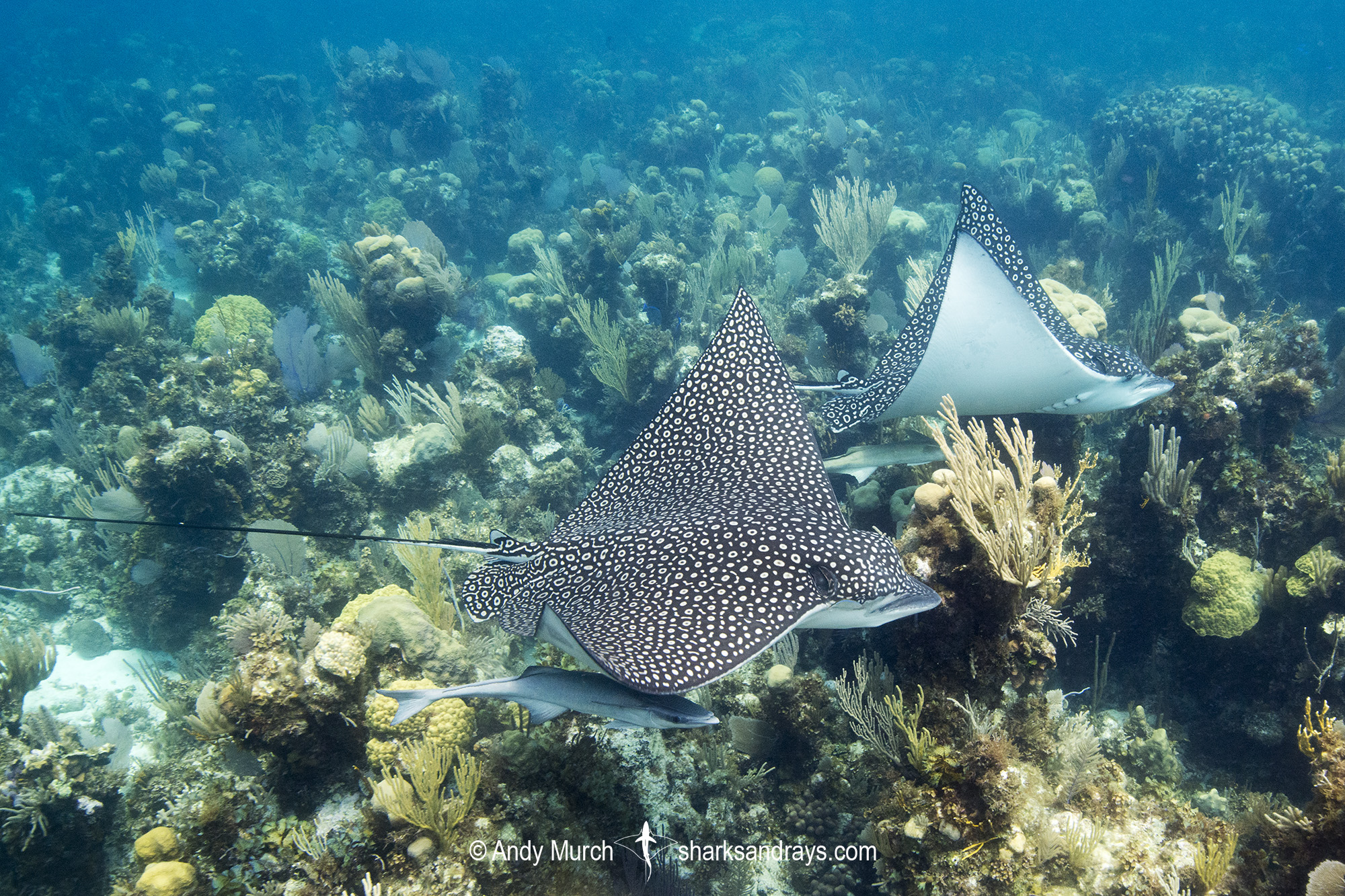Common name(s)
Spotted Eagle Ray, Whitespotted Eagle Ray.
Identification
A large ray with a rhomboidal disc that is more than 1.5x wider than long. Large, protruding head with a moderately long, parabolic rostral lobe. Spiracles large. Mouth slightly narrower than pre-oral (rostral lobe) length. Nasal curtain large and deeply grooved. Powerful pectoral fins have straight anterior margins, concave posterior margins, and falcate, pointed apexes. Pectoral fins originate level with eyes. Disc entirely smooth; lacking thorns. Tail filamentous; 1.8-2.3 x disc width when intact. One or two tail spines that are sub-equal to pre-oral length.
Colour
Dorsum grey to almost black or grey-brown with numerous white spots or small rings. Tail unmarked. Ventrum white.
Size
Max. disc width at least 230cm but usually less than 140cm.
Habitat
Tropical and warm-temperate seas. Sandy bays, coral reefs, and rocky outcrops. Sometimes enters lagoons and estuaries. Often seen swimming close to the substrate, but also common in midwater and near the surface. Intertidal to at least 60m depth.
Distribution
Previously thought to be circumtropical but the spotted eagle rays have recently been split into at least three regional species. A. narinari is now considered an Atlantic endemic, occuring along the western edge of the tropical/warm temperate Atlantic and possibly on the west coast of Africa. In the Americas, this species occurs from North Carolina to Brazil.
Further study may reveal that eastern and western Atlantic populations are unique.
Conservation Status
NEAR THREATENED
The spotted eagle ray complex is listed as NEAR THREATENED by the IUCN. However, this is based on the incorrect assessment that Aetobatus narinari is a globally occurring species. The revised distribution is far more limited (see Distribution above). The Western Atlantic population probably faces a considerably lower threat level. Whitespotted eagle ray populations in Florida are completely protected, while populations within the Caribbean are not fished commercially.
Eastern Atlantic populations (if they are the same species) are probably under greater threat as subsistence fishing is more prevalent and protection is non-existent.
Citation
Kyne, P.M., Ishihara, H, Dudley, S.F.J. & White, W.T. 2006. Aetobatus narinari. The IUCN Red List of Threatened Species 2006: e.T39415A10231645. https://dx.doi.org/10.2305/IUCN.UK.2006.RLTS.T39415A10231645.en. Downloaded on 25 January 2021.
Reproduction
Matrotrophic viviparity. 4 pups per litter.
Diet
Diet consists mainly of invertebrates including polychaetes, bivalves, gastropods, cephalopods, and shrimps. Also consumes small demersal fishes.
Behavior
May be found solitary or in aggregations/schools. Excavates deep holes in the sand to capture benthic invertebrates. Known to breach. One record of a tail spine envenomation when a breaching spotted eagle rays landed in a boat.
Reaction to divers
Usually shy around scuba divers but can be approachable when digging for food.
Diving logistics
Spotted eagle rays are one of the most frequently encountered ray species in Florida and the Caribbean. Some of the best areas to see them are in Mexico, the Bahamas, and Turks and Caicos, but they can be seen virtually anywhere in the Caribbean Sea.
One of the most consistent spotted eagle ray dives is in Cancun, Mexico. At wreck C-58, it is quite common to spot 20+ eagle rays gliding back and forth. With so many eagle rays concentrated in one area, the surrounding reef dives are pretty good too.
What’s new
View our full list of updates
Similar species
No other spotted eagle rays have been recorded from the Atlantic Ocean.




